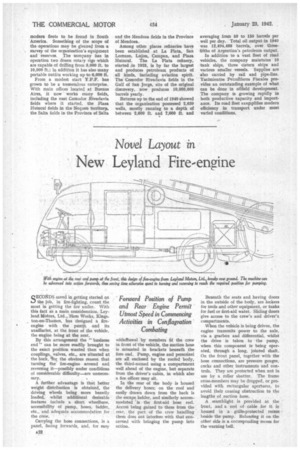Novel Layout in
Page 24

If you've noticed an error in this article please click here to report it so we can fix it.
New Leyland Fire-engine
Q EC 0 14) saved in getting started on ti:1.e job, in fire-fighting, count the most in getting the fire under. With this fact as a main consideration, • Leyland Motors, Ltd., Ham Works, Hingston-on-Thames, has 'designed a fireengine with the pump, and its auxiliaries, at the front of the vehicle, the engine being at the rear.
By this arrangement the ." business end can be more readily brought to the exact position wanted than when couplings, valves, etc., are situated at the back, 'for the obvious reason that turning the fire-engine around and reversing it—possibly under conditions of considerable difficulty—are unnecessary.
A further advantage is that better weight distribution is obtained, the driving wheels being more heavily loaded, whilst additional desirable features include a short wheelbase, accessibility of pump, hoses, ladder, etc., and adequate accommodation for the crew. • Carrying the hose connections, is a panel, facing forwards, and, for easy
withdtawal by members 6f the crew in front of the -vehicle, the suction hose is mounted in brackets beneath the fore end. Primp, engine and personnel are all enclosed by the roofed body, the third-named using a compartment well ahead of the engine, but separate from the driver's cabin, in which also a fire officer may sit.
In the rear of the body is housed the delivery hoses; on the roof and easily drawn down from the hack is the escape ladder, and similarly accommodated 'is the first-aid hose reel. Access being gained to these from the rear, the part of the crew handling them does not interfere with that concerned with bringing the pump into action. Beneath the seats and having doors in the outside of the body, are lockers for tools and other equipment, or tanks for fuel or first-aid water. Sliding doors give access to the crew's and driver's, compartments.
When the vehicle is being driven, the engine transmits power to the axle, via a gearbox and differential, whilst the drive is taken to the pump, when this component is being operated, through a long, jointed shaft. On the front panel, together with the hose connections, are pressure gauges, cocks and other instruments and controls. They are protected when not in use by a roller shutter. The frame cross-members may be dropped, or provided with rectangular apertures, to avoid their causing obstruction to the lengths of suction hose.
A searchlight is provided at the front, and a reel of cable for it is housed in a grille-protected recess beside the pump. Balancing it on the other side is a corresponding recess for the warning bell.
























































